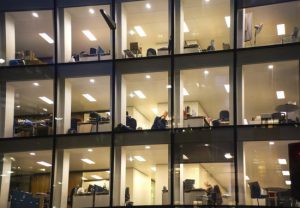Office work can be visually demanding, particularly when it involves staring at a computer screen for an extended period of time. Lighting is one of the most important features of an office as it can have a major impact on productivity and levels of absenteeism.
Here are our top tips on how to make the most of lighting in your workspace.
Reduce high levels of absenteeism with good lighting
Artificial light sources cause glare or flicker on visual display units which are linked to many ocular-related complaints such as eye strain, blurred vision, dry eyes and headaches. Health issues caused by inadequate lighting are not restricted to the eye. It can also contribute to spinal complaints and other musculoskeletal injuries which occur when people adopt awkward postures while straining to read something under poor lighting conditions.
It can also be a contributing factor in offices affected by sick building syndrome, a term that describes high levels of absenteeism in a workplace thought to be linked to various environmental factors, so don’t allow lighting to become a health hazard in your office.
It is important to get the balance of light right in order to avoid employees developing health complaints. Lighting should provide enough illumination so that staff can clearly read printed or handwritten documents but not be so bright that it causes glare.
Levels of productivity can be influenced by lighting
Lighting can influence the efficiency of your employees. A study found that people who work in artificial light are more likely to feel tired towards the end of the working day, whereas those who work in natural light are able to continue working for longer.
Researchers have also found there is a strong correlation between exposure to natural light during work hours and sleep, activity and quality of life. Workers with windows in the workplace received an extra 173% white light exposure during work hours and slept an average of 46 minutes more each night. Those without windows had higher levels of daytime dysfunction.
Both studies suggest that to get the most out of your employees it is important to utilise as much natural light in the office as possible. This will increase the productivity of the workforce meaning the business can become more efficient.
How to ensure your office is suitably lit
A good visual environment will have sufficient light that provides good, but not excessive, good contrast between the task and the background. Overhead lighting can also be adjusted to prevent glare and flicker on monitors. Make sure they are dimmed to a level so that the room is still sufficiently illuminated without being too dark. Filters can also be used to diffuse fluorescent lighting.
Maximise natural light in the office by using an open plan layout and positioning desks by windows. Adjustable blinds can be attached to the windows if employees feel the need to adjust the lighting conditions.
It’s not just lighting that can prevent illumination issues. Matte finishes should be used on walls, floors and furniture to prevent glare. Computer monitor brightness and contrast can be adjusted according to the user’s preference. The monitor itself should be angled away from lights and windows.
Taking these prevention measures into account should ensure you have a happy, healthy and efficient set of employees.

